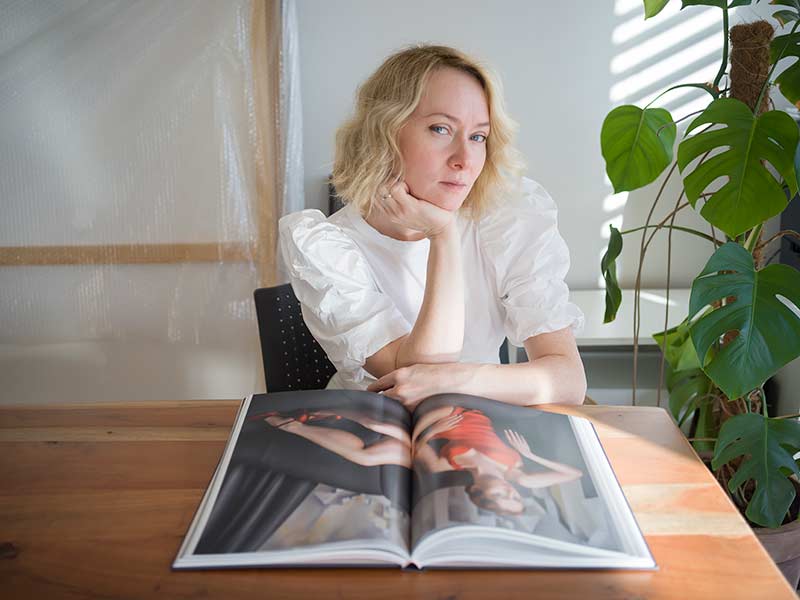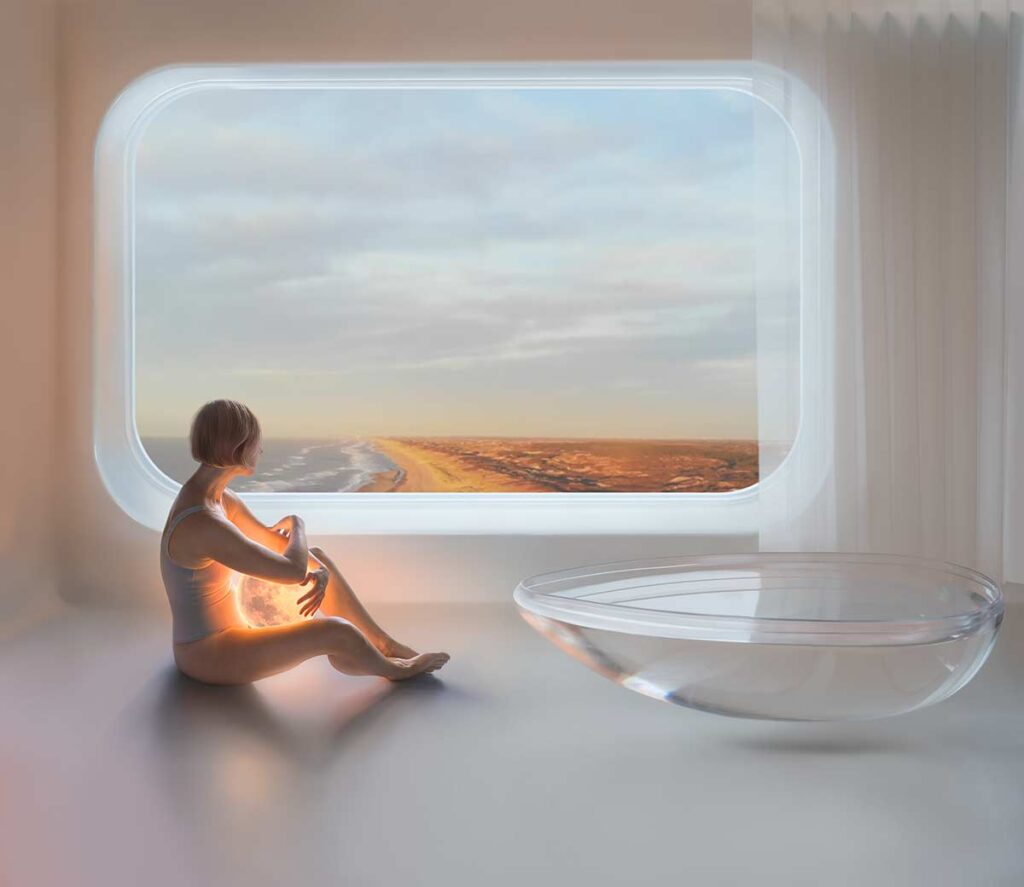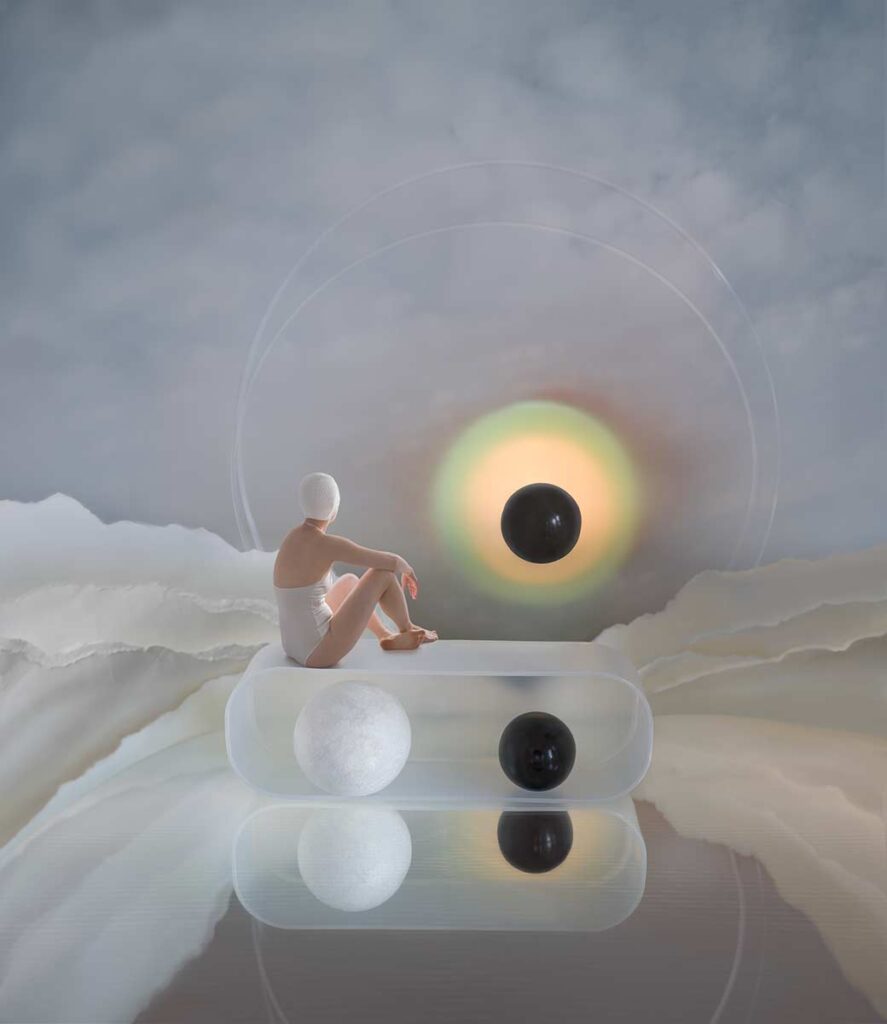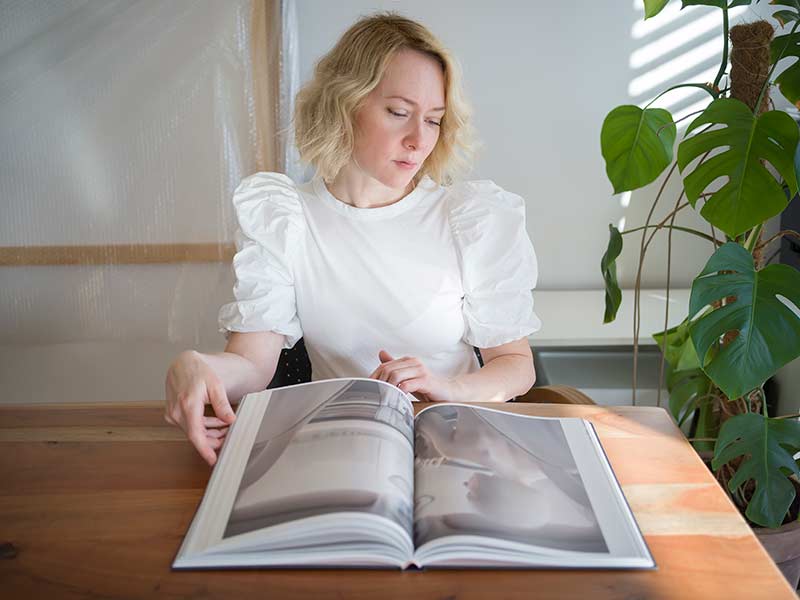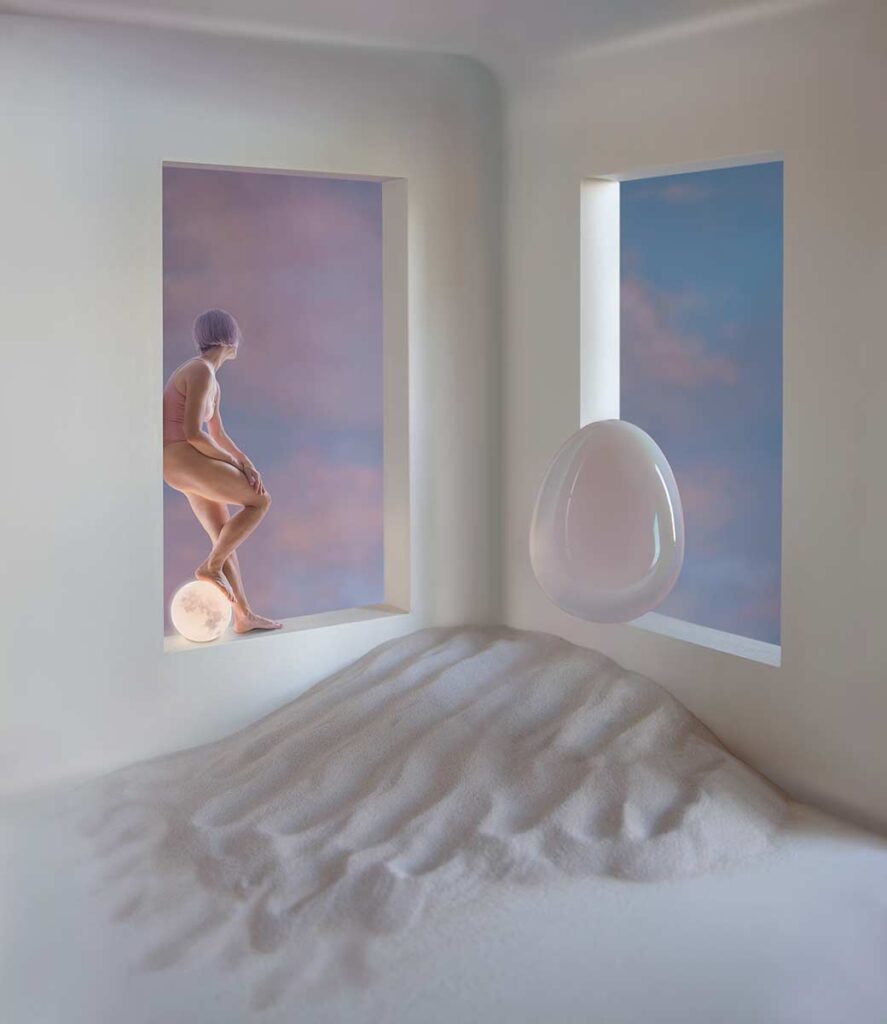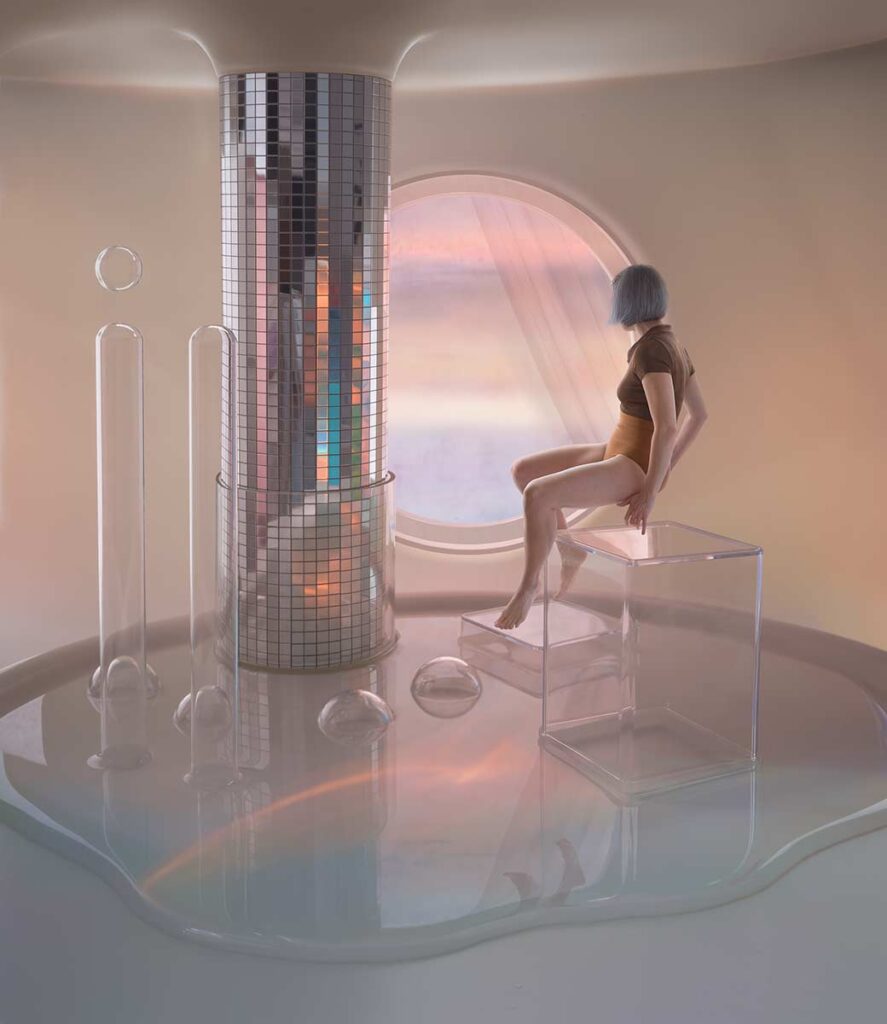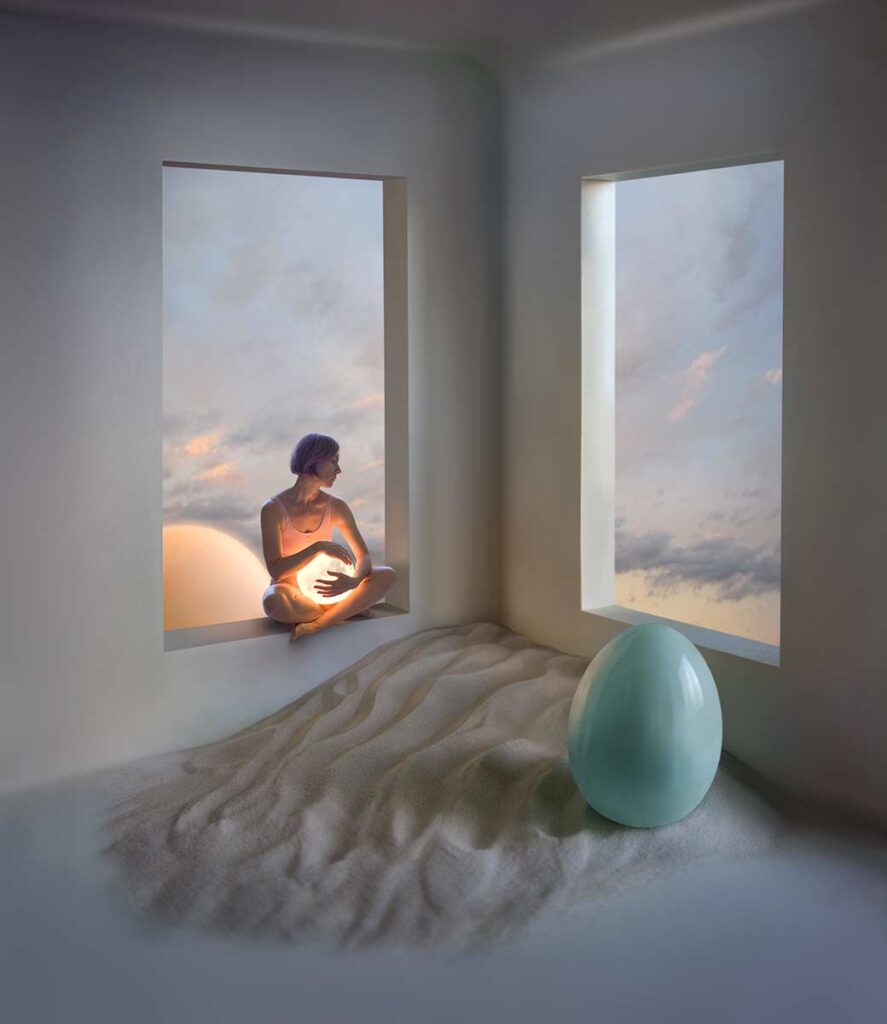
KATERINA BELKINA | FOR ALL MANKIND
“I dream about space, about planets and universes. It is always about the future, romance, and excitement.
Yet, at the same time, I am also rooted in the here and now and think about my home, planet Earth. What’s wrong with me? What’s wrong with the human beings on this Earth?”
Early on, Katerina Belkina (b. 1974) knew about her exceptional talent for seeing the world through different eyes. Born in Samara in the southeast of European Russia, she was brought up in a creative atmosphere by her mother, a visual artist. Her education at the Art Academy and the School for Photography of Michael Musorin in Samara gave her the tools to visualize her ideas. Exhibitions of her sublime, mystic self-portraits ensued in Moscow and Paris. Katerina Belkina was nominated for the prestigious Kandinsky Prize (comparable to the British Turner Prize) in Moscow in 2007. She won the International Lucas Cranach Award in 2015 and the prestigious Hasselblad Masters Prize in 2016. Currently, she lives and works in Werder (Havel).
FOR ALL MANKIND
I dream about space, about planets and universes.
It is always about the future, romance, and excitement. Yet, at the same time, I am also rooted in the here and now and think about my home, planet Earth. What’s wrong with me? What’s wrong with the human beings on this Earth? There is so much suffering everywhere that people do not want to be where they are; they believe there must be a better world somewhere. What difference can a single citizen of the Earth make? One singular, microscopic human being cannot solve anything.
But our mind is its own universe, different for every single one of us. And in this universe, we can create our own reality, our own phantoms, which become the reasons for our decisions, actions, and historical facts.
Now, in yet another difficult moment in our history, I imagine that we can find comfort in our own imaginary space full of planets, stars, and even galaxies that we have created. After all, we were born to live in space, and indeed, we do.
I walk around my house collecting all kinds of objects that have nothing to do with each other: simple materials, paper, stones, and even flour. I find a little corner by the window and build a strange, imaginary, alien landscape in this nook. Little by little, it becomes real. I arrange one of my chosen planets. I will place myself on that one. Another one is placed in my arms. I will endow it with the essence. As if there are two equivalent cosmic bodies: something outside our powerful and influential atmosphere, ruling tides and people, and our personal one – our own totem.
I overcome my fears by focusing on timelessness and, simultaneously, on the moment in its impermanence. We often miss out on being in the moment because we are so busy living our lives. But being in the moment is perfect for marveling at life. And being here reminds me that I can stop time anytime, and we can if we want to.
It may be hard, but it is so simple.
Getting To Know: Katerina Belkina
“In my creative work, I am not searching for the subjects of thought. They spring from everyday life and observations of situations and people. Choosing a motif for my exploration, I offer the audience a unique female view on things that concern me. Undoubtedly, this view is based on feminist principles. Yet, the matter is not in confrontation but in balance and harmony, where a woman is not an object but, foremost – energy.”
Lens Magazine: Please share the background of your photography journey. Did you grow up in a creative environment? What led you to the fine art photography field?
Katerina Belkina: First of all, I would like to distance myself from photography and my position as an artist first, and this is not because I respect photography less as a form of art; I just want to be in the honest position in relation to a viewer. More accurately, I use photographs as material for my future compilation and print the ready artworks on paper, but I still use other media, especially now. I do a lot of videos and also some audio experiments. So fine art photography is not my goal.
Yes, I aspire to some aesthetics in the images, but it was always my primary concern to convey my thoughts and feelings rather than a beautiful picture. I’m from a half-artistic, half-mathematician family. I was born surrounded by passionate male family members for photography.
I inherited a boundless interest in photography from them. In the 4th grade, I signed up for a photography children club where I learned to shoot on film, develop it myself, and print. A bit later, I got my first camera. From female members of my family – my painter mother – I took knowledge and love for art. Not long ago, there were two manifestations of myself, drawing and taking photographs. I did them in parallel as two hobbies, and then my own technique appeared, which is also my method of communication with a viewer.
Lens Magazine: Where your inspiration comes from? Is your artistic style influenced by other photographers or a specific art field?
Katerina Belkina: Usually, photography is not a source of inspiration for me. As a child, I was influenced by classic art, literature, and dance.
To a large extent, nature, cinema, and hybrid art inspire me. And my art style came from experimenting with the images. I used to lack physical pixels (not enough good cameras in the past), and I took many photos and combined them into one big image. It also allowed me to act like a painter, creating work based on my fantasy, not made only from the facts in the photo.
It has developed into an artistic style, and now I have good equipment, but I see it as something other than the most essential for creativity. As an artist, I realized that I love transformation; I strive to purify reality and remove unimportant details, leading the viewer to the main message.
Lens Magazine: Tell us about the workflow process from the step of the idea until the final outcome. Which program do you use for editing? Do you see post-processing as the primary time investment in your work?
Katerina Belkina: I always catch myself at first on some strong emotions in connection with the circumstance and place. This is the starting point. Then I want to transform these emotions into artistic images. At that very moment, I realize what kind of a character I need to be for the artwork/theme and what the task is in this particular story; then, all that remains to create a new world necessary for this character or characters. Then some research begins, and a wave of insights starts. What, where, how. The brain solves these tasks instantly. I just need to choose what corresponds to the intended world. Sometimes I do not even have time to half-think, but it floats up and floats to the surface. I just need to select the most suitable details and ideas. This is a quest. I’m getting more and more excited by it all.
During this period, I have a lot of daydreaming and sometimes do some sketches. After all discoveries,
I usually have a shooting, then compilation and digital drawing. I mainly invest time in the process of thinking and living in the project’s atmosphere; It is necessary for future artworks. Photography is the fastest and easiest part. The drawing takes two to four weeks. Every detail must be brought to perfection, as I see it. I love refining details because this way, I have time to decide what and how things should work in the image. This applies to the elements, composition, tone, and color palette.
Lens Magazine: From your personal journey in the fine art photography field, what will be your advice to the young photographer looking for a way of development?
Katerina Belkina: Two things are essential: to start learning in your subject as early as possible (self-education as well), but never too late, and practice in different art areas until you reach the most existing.
The hours spent on what we love is the key importance, but only if the process interests us. At the same time, nothing should cancel the routine. Inspiration is nothing else than a cocktail of interest and regular work. Open your eyes and look around, and collect the moments that are so bright and so beautiful, even little details and some nice seconds. This is all you can use on your powerful and weaker moments for the creation process. That’s your baggage.
Develop fearlessness in artistic practice. Do not be afraid of experiments and searches, both in the field of style, techniques, and materials and in the psychology field; the deeper you look into yourself, the more honest and attractive your art will be for the viewer. Combining mystery, your unique soul, and your life path will make your art unique and inimitable.
Lens Magazine: What’s the future hold? Any special exhibitions in the upcoming months?
Katerina Belkina: At the moment, I am taking part in the group exhibition NordArt, and I am delighted that I was selected as a finalist with the opportunity to present my work both at the Florence Biennale event in October and in this special edition of Lens Magazine.
It has always been fascinating for me to explore the psychology of people’s relationships with each other and with the outside world, to give shape to human emotions. To take joy, despondency, indifference, rapture, and jealousy to pieces. Feelings are abstract; therefore, looking for and finding the form of their visualization is so interesting.
My face and body are the main instruments to incarnate my desired images. Standing in front of the camera as a model, I follow the age-old theatrical role-playing practice. It gives impetus to the development of my own manner of narration. A part of my work, shooting, is akin to a theatrical performance, where an urge to tell the viewer about emotions and feelings manifests itself through the characters’ dialogues with the audience.
My passion for classical art and interest in everything new, technology, discoveries, and experiments led me to the type of mixed media I work with. From painting, I take colors and create air as an element of space. Reality and character I take from photography.
My style originates from a long artistic tradition of collage. That is how my characters and spaces come together. In the next stage, I choose a brush from a graphics program. This is a subtle and accurate tool to create a light, weightless atmosphere similar to a dream creation.

